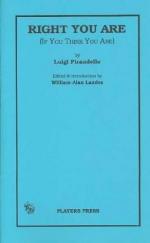|
This section contains 280 words (approx. 1 page at 400 words per page) |

|
Right You Are, If You Think You Are Summary & Study Guide Description
Right You Are, If You Think You Are Summary & Study Guide includes comprehensive information and analysis to help you understand the book. This study guide contains the following sections:
This detailed literature summary also contains Bibliography and a Free Quiz on Right You Are, If You Think You Are by Luigi Pirandello.
As with many of Pirandello's plays, Right You Are, If You Think You Are is an adaptation of one of his short stories, "Signora Frola and Signer Ponza, Her Son-in-Law," published in 1915. The story concerns the conflicting versions of the truth told by the characters of the title, and comes right to the point by declaring that one of them is mad. Determining which one is mad, and where fantasy meets reality, is the focus of the play and of the townspeople. Signora Frola explains that her son-in-law went mad when her daughter, his wife, died four years ago, then remarried but fantasizes that the new wife is his old wife. For his part, Ponza claims that Signora Frola could not accept her daughter's death, went mad, and only survives by believing that his second wife is in actuality her living daughter; it is for this reason, he says, that he guards his wife so jealously. In the play, as Renate Matthei describes in her 1973 work on Pirandello, "the social role built up by one character for himself is continually destroyed by another, devaluated into a sick sham existence that outsiders accept as real only out of pity." Neither the short story nor the play gives the satisfaction of an answer; in fact, the ambiguities expand as the townspeople press for more data in their vain attempts to fix reality through the unreliable medium of perception. Both the play and the short story are representative of Pirandello's obsession with the fine line between fantasy and reality as they are experienced in human consciousness. As he explained to his son in a 1916 letter, the plot is a "great deviltry."
Read more from the Study Guide
|
This section contains 280 words (approx. 1 page at 400 words per page) |

|



